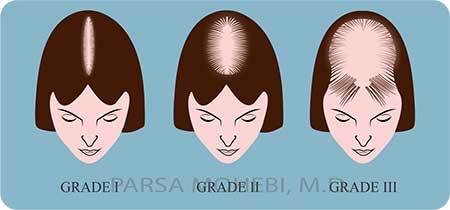Women’s Hair Loss
Women’s hair loss can be the result of genetics, aging, or hormones, and women suffering from hair loss can experience either female patterned baldness (FPB) or male patterned baldness (MPB). There are multiple female hair loss treatment options available for women experiencing thinning hair on the top of the head female hair loss. This article will give female hair loss patients an overview of the reasons for the condition and some common treatment options.
Women Hair Loss Causes
While there is less information that is currently known about all of the causes of female patterned baldness, some of the most commonly recognized causes include the aging process, hormonal changes that affect women experiencing menopause, and genetics. In general, female patterned baldness results in miniaturized hair that becomes much finer in texture and appearance than regular hair (as time passes).
Female Hair Loss Pattern and Grading
It is well-known that female patterned baldness shows a different progression than the progression that is associated with male pattern baldness. Women hair loss patients with this condition will experience a gradual amount of thinning on the scalp while still being able to maintain the look of their front hairline.
Take the first step towards your hair transformation.
Fill in the form to begin your life-changing hair restoration journey today!
A less common hair loss progression is seen when women experience symptoms of male patterned baldness with a recessed frontal hairline. Thankfully, this type of hair loss progression normally does not lead to the complete hair loss that is often seen in male patients experiencing male-patterned hair loss.
Examples of Typical Hair Loss Patterns in Women
The hair loss progression that is usually viewed on the head of female patients is seen as a diffuse thinning over the entire scalp.
Ideal female hair transplant candidates might show some thinning hair on top of the head and female hair loss progression (while still having intact hair on the sides and back of the head). Most women with female patterned baldness show more thinning on the top and crown sections of the scalp while others will show thinning that also has an impact on the front hairlines and corners.
The female hair loss condition that is considered to be the most difficult to treat is known as Diffused Unpatterned Alopecia (DUPA) because the thinning of the hair does not follow any certain pattern. In other words, patients with DUPA see thinning on the donor areas along with the top, front, and crown areas.
Additional Women Hair Loss Causes
Some of the other factors that can result in the loss of hair in female patients include Telogen Effluvium (TE), or temporary hair shedding, and it is associated with sudden stress from childbirth, high fever, severe illness, side effects to common medications such as antidepressants and beta-blockers and medical conditions including Lupus and Alopecia Areata.
Additional causes of hair loss can include hairstyling products that harm the hair, trichotillomania (a psychological condition that involves the involuntary pulling of the hair) and scarring conditions.
Female Hair Loss Treatment Options
Before making the decision to have a hair transplant, female patients should undergo a basic lab test in order to rule out easily treatable medical disorders. In addition, Rogaine (topical minoxidil 2%) is viewed as the most popular medical treatment for women suffering from female patterned baldness.
After the scalp of the patient has been examined by the doctor, a female hair transplant could be an effective solution for many women. The female patients who will benefit the most from a hair transplant are those who have male patterned baldness since the hair will be preserved on the back and sides of the head. In addition, balding or thinning will be limited to some of the areas located on the top, front, or crown. Plus, women who have a very high forehead are also considered to be ideal candidates for a hair transplant.
It should be noted that some women will likely not benefit from a hair transplant due to an excessive amount of diffuse thinning across the entire head (including the possible donor areas). In these cases, patients should consider other options of a nonsurgical nature. If female patients have lost their hair because of other medical conditions, these underlying conditions needs to be treated completely before they have a hair transplant.

